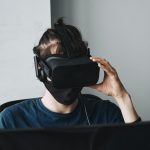University, the one place where you can call your educators by their first name but that’s not the only cool thing about the establishment anymore. In universities across the country, educators are utilising VR (virtual reality) to further enrich a student’s education.
As already discussed in ‘The Future of E-Learning is Immersive VR’ the way that individuals learn is becoming more digital. As businesses are gradually coming around to employ VR into their training, universities are utilising the device to educate students about a variety of subjects across many degrees and in many ways. Take a look at these universities which are already using VR:
- University of Tasmania
- Utilises VR to showcase to future students the campus, upon which prospective students can decide to or not to attend the institution.
- University of New South Wales
- Employs VR technology in its engineering department through the Advanced Visualisation Lab. The VR and AR technology is utilised to stimulate mine environments, in order for students to understand the theories in a practical manner.
- University of Sydney
- In the School of Psychology educators are using VR during Covid-19 times to ensure the students are comprehending the therapies required for a variety of conditions such as phobias, PTSD, pain, and eating disorders.
As seen above, many major universities in Australia are beginning to integrate VR technology into their learning modules. As such, in what more ways can VR be used in a university setting?
- For The University Itself
Online tours of campus have become more commonplace in current society, due to the pandemic and prior because of convenience. Numerous Australian universities have already begun to offer this to potential and current students, such as University of Technology in Sydney which have created an app to further streamline the VR experience. In the app, you can also explore specific facilities in a more in depth manner, so that it is not just a shallow view of the campus.
- Actual Education
This is the most obvious one because VR technology is already being employed in workforces to train employees, ergo, this is no different for educational institutions. Although, if one goes deeper into why VR is more beneficial for students, it’s obvious to see that there are many positives. Such as remembering more of the content as it is so immersive, and attaining more soft skills because the students are learning the theories of the subject matter whilst simultaneously applying it in a practical manner.
Students can learn at their own speed without having the added pressure of classmates or lecturers. Students can also rent VR devices to learn the content in their own time as done in the University of Technology Sydney and La Trobe University in Melbourne. Individualised learning is equivalent to a better understanding of the content and a more satisfactory outcome.
This sentiment is reflected through Dr Aaron McDonald (La Trobe University) who states that it “allows students to visualise and manipulate anatomical structures and develop a deep understanding. You can superimpose anatomical structures over a peer who can perform movements along with the app, to better understand muscle function. It is a great resource for both team work and self-directed learning”
- For Teachers
In times as uncertain as now, because of the pandemic, educators need to find innovative ways to teach their students. VR is a perfect vehicle for this, as it delivers more efficient and clear lessons for learners. Teachers can also streamline modules by having recorded simulations and spending more time creating richer lecture material, better lesson plans, or providing more support for individual students. Through VR, teachers do not need to book expensive trainers or industry professionals to provide insight upon subjects, but rather can provide VR simulations that are actually more catered and effective.
- For Student’s Future Careers
According to PwC, the VR industry will rise in value exponentially over the next decade, from $13.5 billion in 2019 to $450.5 billion by 2030. As VR is moving towards maturation, it will likely become a mainstream tool for firm operations in both the business-to-consumer (B2C) and business-to-business markets (B2B).
VR is becoming more prevalent as a force in modern society, as such, it is important to equip current students with skills that will prepare them for the future. VR is used as a long-term solution for businesses in their ongoing training as well as in daily operations. It is now being employed in a variety of industries such as IT, Architecture, Engineering, Medical Fields and retail as demonstrated by multinational corporations such as Walmart.
As universities around the country are beginning to embrace VR devices, businesses should follow suit and stay ahead of other companies.
Written by Belinda Saha
Similar articles to check out:







